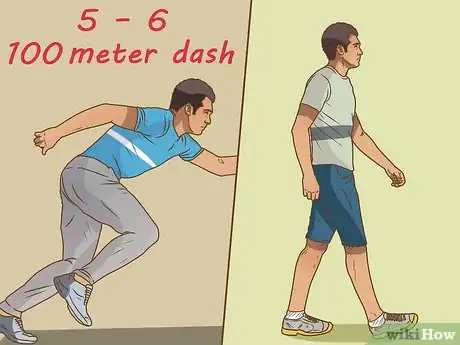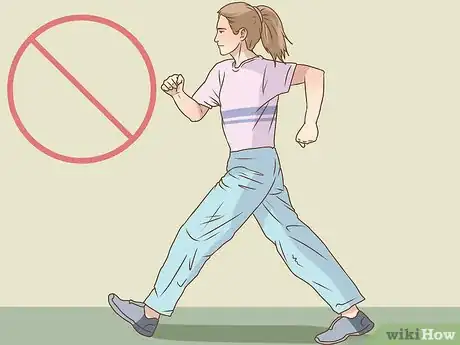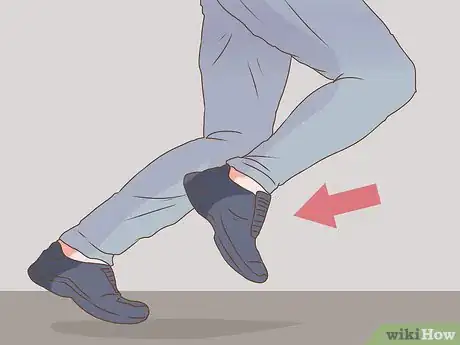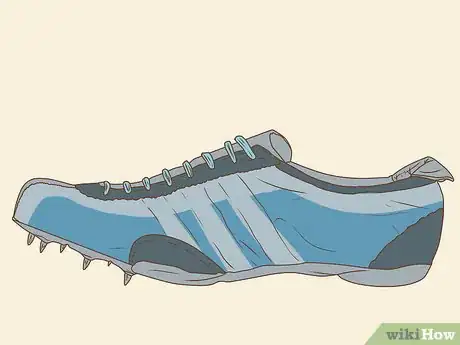This article was co-authored by Tyler Courville. Tyler Courville is a brand ambassador for Salomon Running. He has run in 10 ultra and mountain races across the United States and Nepal, and won the 2018 Crystal Mountain Marathon.
There are 9 references cited in this article, which can be found at the bottom of the page.
wikiHow marks an article as reader-approved once it receives enough positive feedback. In this case, 86% of readers who voted found the article helpful, earning it our reader-approved status.
This article has been viewed 72,278 times.
Sprinting has health benefits such as strengthening the cardiovascular system, and is a great way to lose weight. It can be quite enjoyable as well! Whether you just want to improve your sprinting technique, or you have your eye on Olympic gold, becoming a faster sprinter is a goal within your reach.
Steps
Getting Stronger and Faster
-
1Map out a training plan and schedule. If you have a particular race for which you wish to prepare, give yourself plenty of time to reach your goals. It may help to define what exactly those goals are. For instance, are you trying to improve your time by 10%, or are you more focused on perfecting your form?
- By writing realistic and attainable goals on a calendar, you are more likely to stay on track with your training plan.
- Make sure that your training plan can be accommodated by your existing schedule. You are more likely to continue making progress toward your goals when training doesn’t become a chore, but is something that you enjoy.
-
2Train with your friends. This can be a huge confidence builder, and a fun way to improve your sprinting. Training with a group or a partner helps you stay motivated when the going gets tough, and pushes you harder than you might push yourself alone.[1]
- Being accountable to a group rather than just to yourself also makes it much more likely that you will achieve your goals.
EXPERT TIPTyler Courville is a brand ambassador for Salomon Running. He has run in 10 ultra and mountain races across the United States and Nepal, and won the 2018 Crystal Mountain Marathon.Professional Runner
 Tyler Courville
Tyler Courville
Professional RunnerTyler Courville, ultra and mountain runner, talks about how you can even make new friends running: “Running is my go to way to make friends if I’m moving to a new city or even a new country. One of the first things I do is look up running clubs. I find that almost all runners are people that I like, so, it gives me a real community.”
Advertisement -
3Build muscle in the weight room. Sprinting requires quite a bit of power, so you’ll need to spend some time working on your strength and muscle. Spending time in the gym will help to break up your training schedule, and is a good alternative to running during inclement weather.
- Try doing some bench presses (3 sets of 6 reps), barbell squats (3 sets of 6 reps), and some chin-ups (10 reps).[2]
- Yoga is another great option for building strength and improving balance.
-
4Warm up before you run. Start with a quick jog around the track to get your legs and body warmed up. This will loosen up your muscles to prevent pulling them.
- Stretch out your legs and hips. Standing with your hands on your hips, try swinging each leg back and forth 25 times.[3]
- After 10 minutes of stretching, you should be warmed up enough to start working out.
-
5Hit the track. If you are a beginning sprinter, start at about 50% of your full speed until you feel comfortable, and you can gradually increase your speed from there. Run about 6-10 100-meter dashes, making sure to walk back slowly to the starting line in order to give your body a rest between .sprints[4]
- If you are still fatigued, wait for 2 minutes before beginning the next dash.
-
6Cool down. After a grueling training session, make sure to let your body cool itself down by walking around the track for a few minutes. Stopping suddenly can cause your legs to cramp.
Improving Your Sprinting Form
-
1Stand up straight. Many runners like to lean forward, as this causes a temporary increase in speed, but you should try to remain upright while sprinting. Good posture will help you run more consistently, run faster, and will help to prevent injuries![5]
- Keep your spine straight, and your head up and looking forward.
- It may help to imagine a string attached to the top of your head being pulled upward.[6]
-
2Avoid over-striding. Make sure that your feet are landing directly underneath your hips, in order to avoid creating too much impact shock to your legs, which can cause injury. Sprinting with a more natural step will help you also to have a more efficient stride.[7]
- With each stride, lift your front knee, and straighten your back leg. Keep your strides short and quick at first, and gradually lengthen your strides as you get closer to the finish line.[8]
-
3Increase your cadence. Cadence is the average number of steps you take with both feet in a minute. You can determine what your cadence is by counting the number of times either your left or right foot strikes the ground in a minute and multiply that number by two.
- Top runners generally have a cadence over 180 steps per minute.
- Try increasing your cadence by using a metronome to train your body to recognize a rhythm that beats at a particular tempo. Keep in mind that it can take 6-8 weeks to improve your cadence.[9]
-
4Pump your arms. Making sure to keep your shoulders and arms relaxed rather than hunched up, allow your arms to move at the same rhythm as your legs, keeping them moving in a straight line rather than from side to side. Try keeping your hands open, and bringing them backward as you sprint.
- Get your arms in the proper position by pretending that you are lightly holding a small bird in each hand.[10]
- Proper arm motion will help you move your legs more quickly as well.
-
5Start off on the right foot. Try putting your quick foot (the one you use to catch yourself when someone pushes you forward) in the rear. Right before you start sprinting, take a couple of deep breaths to super-oxygenate your lungs.
Preparing for Race Day
-
1Make healthy food choices. You are what you eat, as the adage goes. In order to give your body proper fuel for running, make sure to eat healthy and nourishing meals in the week prior to your race. As a runner, you will be burning plenty of calories, so it is important that you replenish your system with nutritious foods. Sprinters in particular should focus on eating proteins and healthy fats for short bursts of energy, rather than carbohydrates which are better suited for long-distance running.[11]
- Try taking in around 1 gram of protein such as chicken, fish, or lean ground beef per pound of body weight per day.
- Eat plenty of dark fruits and vegetables such as kale, blueberries, and raspberries. They should make up about 30% of your diet.
- Satisfy your snacking cravings with healthy fats such as natural peanut butter, almond butter, and avocados.
- Avoid sweets and heavy meals.
-
2Stay hydrated. Drink plenty of water on the days leading up to your race. On race day itself, make sure to drink 8-16 ounces of water 1-2 hours before your run, but avoid taking in too many fluids in the last 45 minutes prior to running unless it is an unusually hot day. Drinking too much water right before sprinting may cause you to have cramps and an uncomfortably full bladder.[12]
- Avoid drinking coffee or alcohol in the days leading up to the race, as too much of either can dehydrate your body.
- To make sure you are hydrating properly after a run, consider weighing yourself before and after the run to see how much fluid you are losing while sprinting. For each pound lost while running, you should drink as many as 24 ounces of water or a sports drink to replenish your fluids.[13]
-
3Get the right gear. All the training in the world won’t do you much good if you don’t have the right shoes. In the sprinting world, a fraction of a second could be all that stands between you and the gold, so make sure your feet have all the help they can get.
- Sprinting shoes, known as track spikes, are built for speed and have built-in spikes that grip the track as you tear toward the finish line. They should be lightweight and fit snugly.
Community Q&A
-
QuestionHow do I run 1600 meters in 5 minutes?
 Community AnswerYou can accomplish this with High Intensity Interval Training (HIIT). Train in intervals of high intensity to increase your speed so you can accomplish your goal.
Community AnswerYou can accomplish this with High Intensity Interval Training (HIIT). Train in intervals of high intensity to increase your speed so you can accomplish your goal. -
QuestionWhat types of food are best to eat before a run?
 Community AnswerFoods that are high in energy, like fruits for example, are great. Try to eat a banana 20-30 minutes before running.
Community AnswerFoods that are high in energy, like fruits for example, are great. Try to eat a banana 20-30 minutes before running. -
QuestionI want to train with somebody, but my friends just make fun of my running. What should I do?
 Community AnswerTry to go to a local gym and meet a few people, or if you have a little extra money, you can invest in a personal trainer. They're more on the expensive side, but the outcome from the training is almost always well worth it.
Community AnswerTry to go to a local gym and meet a few people, or if you have a little extra money, you can invest in a personal trainer. They're more on the expensive side, but the outcome from the training is almost always well worth it.
Warnings
- Try to avoid eating an hour before the race.⧼thumbs_response⧽
- Avoid drinks like soda and juice after a run. They aren’t as good at rehydrating your body, and often have unnecessary excess sugar.⧼thumbs_response⧽
References
- ↑ http://www.theactivetimes.com/new-moves-competition-and-8-other-benefits-working-out-friend-slideshow
- ↑ http://www.mensfitness.com/training/endurance/train-like-an-olympic-sprinter
- ↑ http://www.bodybuilding.com/fun/sprint_training_sculpts_body.htm
- ↑ http://www.bodybuilding.com/fun/sprint_training_sculpts_body.htm
- ↑ http://www.fitday.com/fitness-articles/fitness/cardio/how-to-improve-your-sprinting-technique.html
- ↑ http://greatist.com/move/proper-running-form-tips
- ↑ http://greatist.com/move/proper-running-form-tips
- ↑ http://activeforlife.com/teach-kids-to-sprint-correctly/
- ↑ http://running.competitor.com/2014/09/training/3-ways-to-increase-running-cadence-for-speed_112765
- ↑ http://activeforlife.com/teach-kids-to-sprint-correctly/
- ↑ http://www.mensfitness.com/training/endurance/train-like-an-olympic-sprinter
- ↑ http://www.runnersworld.com/hydration-dehydration/prevent-dehydration-while-running
- ↑ http://www.cheatsheet.com/life/drink-up-before-you-run-yourself-down-5-tips-for-running-hydration.html/?a=viewall








































































